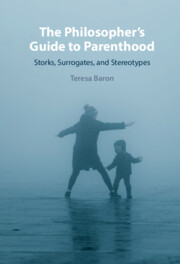Refine search
Actions for selected content:
31 results
14 - The Legal Situation Regarding Assisted Reproduction in Iran
-
-
- Book:
- The Rule of Law in the Islamic Republic of Iran
- Published online:
- 10 April 2025
- Print publication:
- 17 April 2025, pp 414-443
-
- Chapter
- Export citation
What Do We Owe Our Genetic Relatives?
-
- Journal:
- Journal of the American Philosophical Association / Volume 11 / Issue 3 / September 2025
- Published online by Cambridge University Press:
- 20 March 2025, pp. 562-580
-
- Article
-
- You have access
- Open access
- HTML
- Export citation
The Effects of Parental Leave on Attitudes Toward the State
-
- Journal:
- Politics & Gender , First View
- Published online by Cambridge University Press:
- 24 February 2025, pp. 1-23
-
- Article
-
- You have access
- Open access
- HTML
- Export citation
Applying Rawls’ Theory of Public Reason to Controversies over Parental Surrogacy
-
- Journal:
- Cambridge Quarterly of Healthcare Ethics / Volume 34 / Issue 1 / January 2025
- Published online by Cambridge University Press:
- 27 January 2025, pp. 49-60
-
- Article
-
- You have access
- Open access
- HTML
- Export citation
4 - When the Hearth Was at Once Warm and Cold
-
- Book:
- Geographies of Gender
- Published online:
- 09 January 2025
- Print publication:
- 23 January 2025, pp 150-184
-
- Chapter
- Export citation
4 - Adopting Change
- from Part I - Queer Partners and Parents
-
- Book:
- Family Matters
- Published online:
- 27 May 2024
- Print publication:
- 01 August 2024, pp 131-160
-
- Chapter
- Export citation
1 - Parenthood Aspirations and Justiciable Rights
-
- Book:
- Procreative Rights in International Law
- Published online:
- 26 April 2024
- Print publication:
- 02 May 2024, pp 11-40
-
- Chapter
- Export citation
Intersectional Motherhood and Candidate Evaluations in the United States
-
- Journal:
- Politics & Gender / Volume 20 / Issue 3 / September 2024
- Published online by Cambridge University Press:
- 27 March 2024, pp. 598-619
-
- Article
- Export citation
5 - The Child’s Right to Identity
-
- Book:
- Fortin's Children's Rights and the Developing Law
- Published online:
- 08 February 2024
- Print publication:
- 29 February 2024, pp 144-198
-
- Chapter
- Export citation
Abortion, Infanticide, and Choosing Parenthood
-
- Journal:
- Dialogue: Canadian Philosophical Review / Revue canadienne de philosophie / Volume 64 / Issue 2 / August 2025
- Published online by Cambridge University Press:
- 19 February 2024, pp. 285-310
-
- Article
-
- You have access
- Open access
- HTML
- Export citation
Chapter 13 - Emotional Labor in Parenting
- from Part IV - Current Trends
-
-
- Book:
- Emotion Regulation and Parenting
- Published online:
- 05 January 2024
- Print publication:
- 30 November 2023, pp 244-263
-
- Chapter
-
- You have access
- Open access
- HTML
- Export citation
6 - From Fledgling to Established Relationships
- from Part II - Relationship Formation
-
- Book:
- The Science of Romantic Relationships
- Published online:
- 17 August 2023
- Print publication:
- 31 August 2023, pp 197-234
-
- Chapter
- Export citation
It all begins when you are a graduate student
-
- Journal:
- Industrial and Organizational Psychology / Volume 16 / Issue 2 / June 2023
- Published online by Cambridge University Press:
- 09 May 2023, pp. 237-241
-
- Article
-
- You have access
- Open access
- HTML
- Export citation
4 - Nelia Pavlova
-
- Book:
- Politics, Murder and Love in an Italian Family
- Published online:
- 13 January 2023
- Print publication:
- 09 February 2023, pp 98-117
-
- Chapter
- Export citation

The Philosopher's Guide to Parenthood
- Storks, Surrogates, and Stereotypes
-
- Published online:
- 15 January 2023
- Print publication:
- 05 January 2023
Chapter 5 - Paradigms and Parental Projects
-
- Book:
- The Philosopher's Guide to Parenthood
- Published online:
- 15 January 2023
- Print publication:
- 05 January 2023, pp 164-189
-
- Chapter
- Export citation
Introduction
-
- Book:
- The Philosopher's Guide to Parenthood
- Published online:
- 15 January 2023
- Print publication:
- 05 January 2023, pp 1-14
-
- Chapter
- Export citation
Conclusion
-
- Book:
- The Philosopher's Guide to Parenthood
- Published online:
- 15 January 2023
- Print publication:
- 05 January 2023, pp 190-191
-
- Chapter
- Export citation
5 - Working with new families throughout the transition to parenthood
- from Part B - Nursing infants, young children and their families
-
-
- Book:
- Paediatric Nursing in Australia and New Zealand
- Published online:
- 05 January 2022
- Print publication:
- 05 January 2022, pp 115-136
-
- Chapter
- Export citation
Slimy worms or sticky kids: How caregiving tasks and gender identity attenuate disgust response
-
- Journal:
- Politics and the Life Sciences / Volume 39 / Issue 2 / Fall 2020
- Published online by Cambridge University Press:
- 03 November 2020, pp. 167-186
-
- Article
- Export citation
